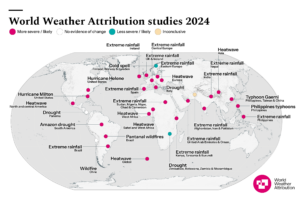
The 2024 Climate Extremes Report: An Annual Overview of Record-Breaking Weather Events
As each December arrives, questions arise about the severity of the year’s most extreme weather phenomena. To provide clarity, we have collaborated with Climate Central to produce this comprehensive report, which evaluates the most significant climate-related incidents of 2024. It also offers fresh insights into how rising temperatures have increased the frequency of dangerously hot days and outlines global strategies for a more resilient and sustainable future in 2025.
Core Highlights and Insights
- 2024 marked a new peak in climate-related disasters, with unprecedented temperatures fueling relentless heatwaves, prolonged droughts, widespread wildfires, intense storms, and catastrophic floods. These events resulted in thousands of fatalities and displaced millions, underscoring how climate change has already transformed daily life with a global temperature increase of approximately 1.3°C caused by human activity. This underscores the urgent need to accelerate the transition away from fossil fuels to mitigate further climate escalation.
- In 2024, climate change was linked to the deaths of at least 3,700 individuals and the displacement of millions across 26 major events analyzed. These figures represent only a fraction of the 219 incidents that met our criteria for impact assessment. The total number of fatalities attributable to climate change-related factors likely extends into the tens of thousands, highlighting the profound human toll of a warming planet.
- According to recent analyses by Climate Central, the number of days with extreme heat globally increased by an average of 41 days in 2024. Vulnerable nations-particularly small island states and developing countries-experienced the most severe impacts, facing health risks and infrastructure challenges. These underreported and poorly understood effects of prolonged heat stress emphasize the need for targeted adaptation strategies.
- While El Niño played a role in some of the year’s extreme weather events, our research indicates that climate change had a more significant influence on many incidents, such as the historic drought in the Amazon rainforest. As global temperatures rise, the overriding impact of human-induced warming increasingly dominates natural climate variability.
- Record-breaking temperatures in 2024 led to a surge in severe rainfall events. From Kathmandu to Dubai, and from Rio Grande do Sul to the Appalachian Mountains, the year was marked by devastating floods. Of the 16 major flood events studied, 15 were amplified by climate change-driven increases in atmospheric moisture, consistent with the physics of a warming atmosphere that holds more water, resulting in heavier precipitation. Insufficient early warning systems and inadequate flood defenses contributed to high death tolls, emphasizing the importance of investing in resilient infrastructure.
- The Amazon rainforest and Pantanal wetlands suffered severe droughts and wildfires, causing significant biodiversity loss. As the world’s largest terrestrial carbon sink, the Amazon plays a critical role in regulating global climate. Protecting these ecosystems from deforestation and promoting reforestation are vital steps to prevent further droughts and fires, as dense vegetation helps retain moisture and stabilize local climates.
- Warmer oceans and elevated atmospheric temperatures intensified storm activity, including notable hurricanes like Typhoon Helene and Typhoon Gaemi. Studies confirm that climate change has increased the wind speeds and rainfall associated with these storms. Between 2019 and 2023, analysis shows that 30 out of 38 Atlantic hurricanes were stronger by at least one category due to warming, and the likelihood of multiple Category 3-5 typhoons striking the Philippines annually is on the rise.

Strategic Goals for 2025
- Accelerating the Shift from Fossil Fuels – Despite the global commitment made at COP28 to phase out fossil fuels, new oil and gas projects continue to be approved worldwide. This ongoing expansion threatens to push global warming beyond the critical 1.5°C threshold, with severe consequences for ecosystems and human societies. Transitioning rapidly to renewable energy sources is essential to creating a safer, healthier, and more equitable planet.
- Enhancing Early Warning Systems – The devastating weather events of 2024 have underscored the importance of timely alerts. Effective early warning systems, especially those providing days’ notice and clear instructions, can significantly reduce loss of life. Investing in and upgrading these systems across all nations-particularly in vulnerable regions-must be a priority to ensure communities are prepared for extreme weather events.
- Real-Time Reporting of Heat-Related Mortality – Heatwaves remain the deadliest climate hazard, yet their risks are often underreported. Recent incidents, such as a hospital in Mali documenting a surge in heat-related deaths at nearly 50°C, highlight the need for real-time health data sharing. Improved reporting can alert health systems and the public to the immediate dangers of extreme heat, enabling quicker responses and better preparedness.
- Financial Support for Developing Countries – As discussed at COP29, mobilizing financial resources to assist vulnerable nations in adapting to climate impacts is crucial. Many of these countries contribute minimally to global emissions but bear the brunt of climate disasters, which hinder development and strain resources. Investing in resilience and adaptation measures will help protect lives, preserve livelihoods, and promote global equity.

